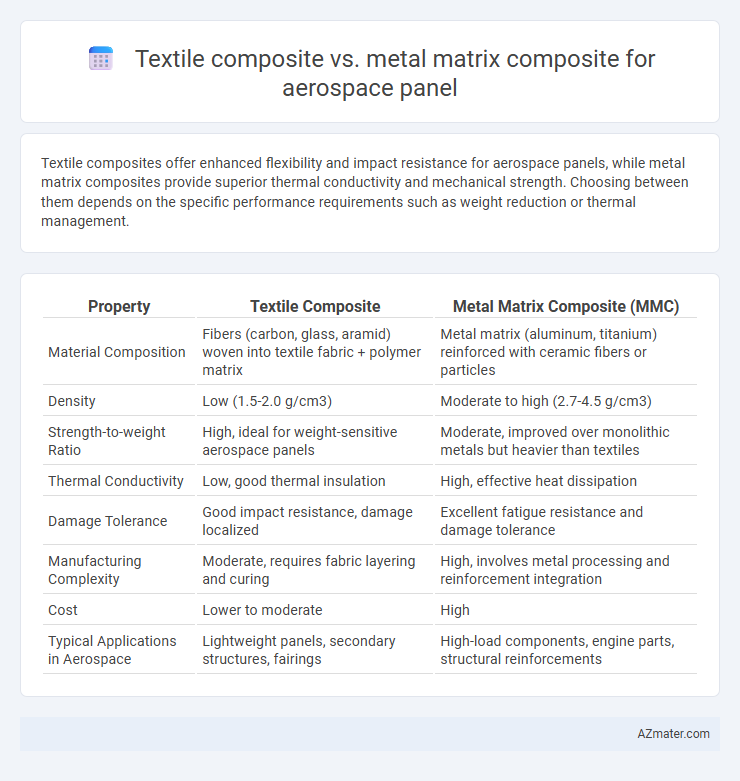Textile composites offer enhanced flexibility and impact resistance for aerospace panels, while metal matrix composites provide superior thermal conductivity and mechanical strength. Choosing between them depends on the specific performance requirements such as weight reduction or thermal management.
Table of Comparison
| Property | Textile Composite | Metal Matrix Composite (MMC) |
|---|---|---|
| Material Composition | Fibers (carbon, glass, aramid) woven into textile fabric + polymer matrix | Metal matrix (aluminum, titanium) reinforced with ceramic fibers or particles |
| Density | Low (1.5-2.0 g/cm3) | Moderate to high (2.7-4.5 g/cm3) |
| Strength-to-weight Ratio | High, ideal for weight-sensitive aerospace panels | Moderate, improved over monolithic metals but heavier than textiles |
| Thermal Conductivity | Low, good thermal insulation | High, effective heat dissipation |
| Damage Tolerance | Good impact resistance, damage localized | Excellent fatigue resistance and damage tolerance |
| Manufacturing Complexity | Moderate, requires fabric layering and curing | High, involves metal processing and reinforcement integration |
| Cost | Lower to moderate | High |
| Typical Applications in Aerospace | Lightweight panels, secondary structures, fairings | High-load components, engine parts, structural reinforcements |
Introduction to Aerospace Composite Materials
Aerospace composite materials like textile composites and metal matrix composites (MMCs) offer unique advantages for panels, combining high strength-to-weight ratios essential for aircraft performance and fuel efficiency. Textile composites utilize woven fibers embedded in resin matrices to provide enhanced damage tolerance and design flexibility, while MMCs incorporate metal alloys reinforced with ceramic fibers or particles for superior thermal stability and load-bearing capacity. Selecting between these composites depends on specific aerospace application requirements such as fatigue resistance, thermal conductivity, and overall structural durability.
Overview of Textile Composites
Textile composites consist of interwoven fibers such as carbon, glass, or aramid embedded in a polymer matrix, offering high strength-to-weight ratios and excellent damage tolerance for aerospace panels. Their flexibility in fiber architecture allows for tailored mechanical properties and enhanced impact resistance compared to conventional metal matrix composites. These composites also provide improved fatigue performance and corrosion resistance, making them suitable for critical aerospace structural components.
Overview of Metal Matrix Composites
Metal Matrix Composites (MMCs) consist of a metal alloy matrix reinforced with ceramic fibers or particles, offering superior strength, stiffness, and thermal resistance compared to traditional metals. MMCs provide enhanced wear resistance, high-temperature stability, and lower density, making them ideal for aerospace panels requiring durability under extreme conditions. These composites outperform textile composites in load-bearing applications due to their improved mechanical properties and thermal conductivity.
Mechanical Properties: Textile vs Metal Matrix Composites
Textile composites exhibit high tensile strength and excellent damage tolerance due to their woven fiber architecture, making them ideal for lightweight aerospace panels requiring flexibility and impact resistance. Metal matrix composites (MMCs) provide superior stiffness, thermal conductivity, and wear resistance, which enhances structural integrity under high-temperature and load conditions common in aerospace environments. The choice between textile and metal matrix composites for aerospace panels hinges on balancing weight savings with mechanical performance demands such as stiffness, strength, and thermal stability.
Weight and Density Considerations
Textile composites offer significantly lower density compared to metal matrix composites, making them ideal for aerospace panels where weight reduction is critical. The lightweight nature of textile composites enhances fuel efficiency and payload capacity, while metal matrix composites, though denser, provide superior thermal and wear resistance. Optimizing the balance between weight and mechanical properties is essential for aerospace applications demanding both lightweight structures and durability under high stress.
Thermal Performance and Stability
Textile composites in aerospace panels offer superior thermal insulation and enhanced damage tolerance due to their fibrous architecture, maintaining stability in fluctuating temperature environments up to 600degC. Metal matrix composites (MMCs) provide higher thermal conductivity and excellent mechanical strength at elevated temperatures exceeding 700degC, ensuring dimensional stability under thermal cycling. Selection depends on operational thermal loads, with textile composites favored for insulation and MMCs preferred for heat dissipation and structural integrity in aerospace applications.
Manufacturing Processes and Scalability
Textile composites for aerospace panels are manufactured using processes such as resin transfer molding (RTM) and automated fiber placement, enabling high fiber volume fractions and complex shapes with excellent damage tolerance. Metal matrix composites (MMCs) require advanced methods like powder metallurgy, infiltration, or stir casting, which offer superior high-temperature performance but involve more complex and cost-intensive manufacturing. Scalability favors textile composites due to their compatibility with automation and lower processing temperatures, while MMCs face challenges in mass production because of higher tooling wear and intricate process controls.
Cost Analysis: Textile vs Metal Matrix Composites
Textile composites generally offer lower manufacturing and material costs compared to metal matrix composites, due to their use of less expensive fibers like carbon or glass and simpler processing techniques such as resin transfer molding. Metal matrix composites involve higher expenses related to raw metals like aluminum or titanium and require energy-intensive processes including powder metallurgy and infiltration, which increase production costs. The cost-effectiveness of textile composites makes them attractive for aerospace panel applications where budget constraints and weight savings are critical.
Durability and Maintenance in Aerospace Applications
Textile composites offer superior fatigue resistance and impact tolerance, enhancing durability in aerospace panels exposed to cyclic loads and vibration. Metal matrix composites provide excellent thermal stability and wear resistance, reducing maintenance frequency in high-temperature environments. Both materials require tailored inspection techniques, but textile composites generally allow easier repair, while metal matrix composites demand specialized maintenance protocols due to their rigidity and thermal conductivity.
Future Prospects and Trends in Aerospace Panel Materials
Textile composites offer enhanced flexibility, weight reduction, and impact resistance, making them increasingly favorable for next-generation aerospace panels focused on fuel efficiency and sustainability. Metal matrix composites (MMCs) provide superior thermal conductivity, strength, and wear resistance, ideal for high-temperature environments and structural applications in aerospace. Emerging trends emphasize hybrid composites combining textile and metal matrices to optimize weight, durability, and performance in aerospace panel materials.

Infographic: Textile composite vs Metal matrix composite for Aerospace panel
 azmater.com
azmater.com